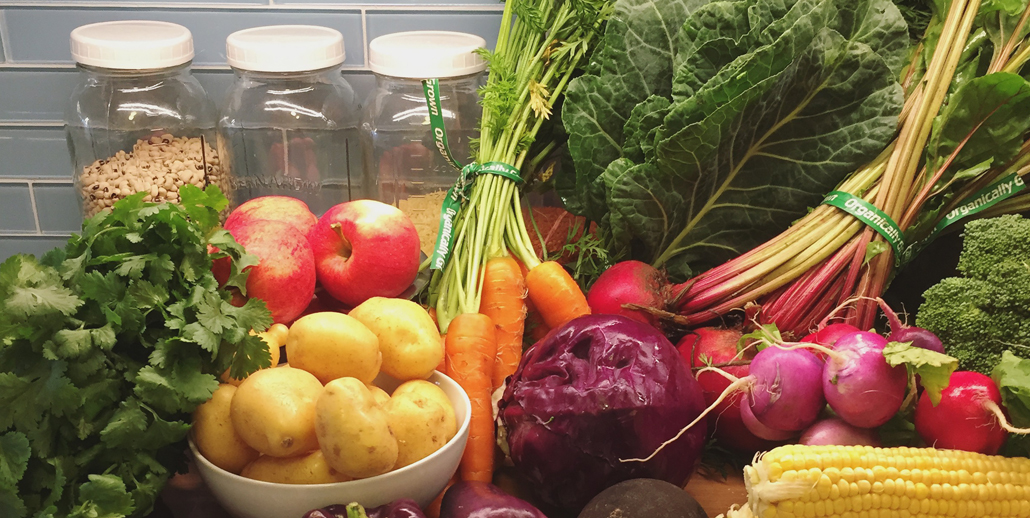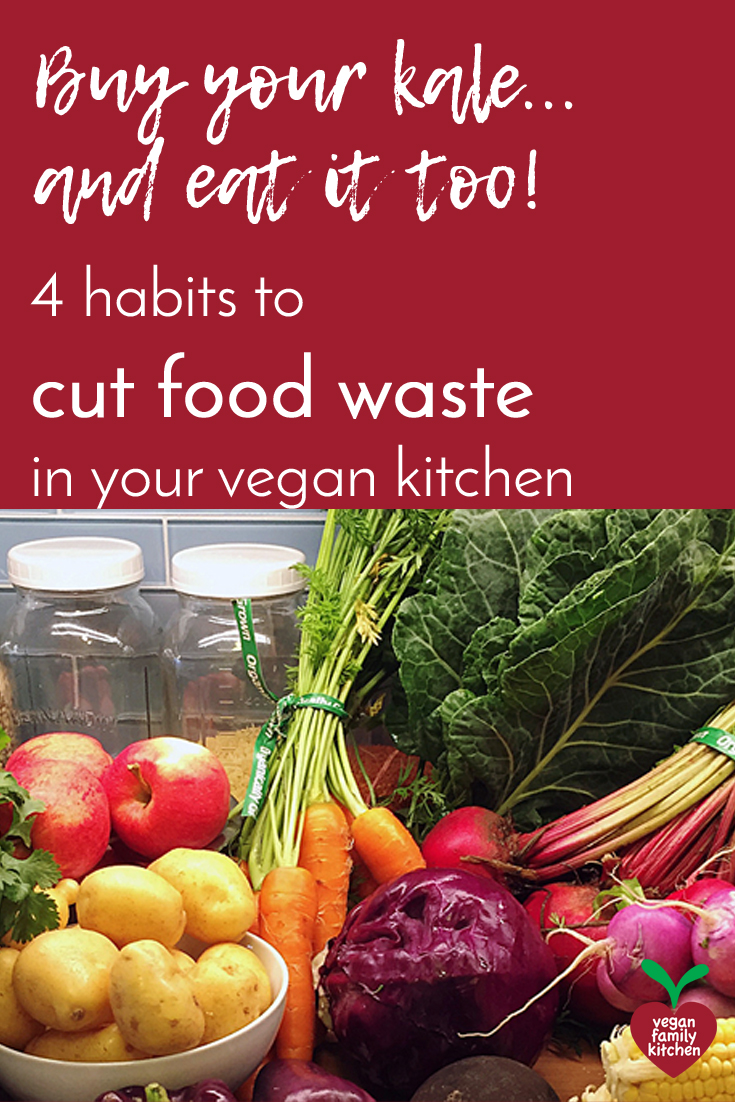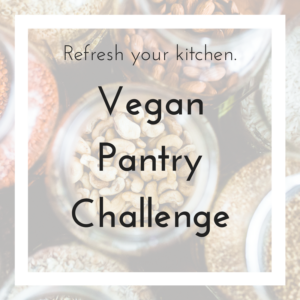How can you cut food waste in your kitchen when cooking vegan, saving the planet and your wallet at the same time?
Picture a Wednesday night. You just got home after a big day. Your preschooler is clamoring for a snack and you wouldn’t mind one yourself. You think you should really get on with cooking that roasted cauliflower and chickpea salad you pinned for tonight instead. As you chase your toddler to change his diaper, you fumble with your phone to find the Moroccan dressing recipe.
Fast forward thirty minutes, your preschooler has found tortilla chips and eaten a generous bowlful of them. You did manage to chop the cauliflower into florets (without dropping your knife on the little person who’s tugging at your skirt) and toss it in a bit of olive oil, but suddenly realize that the oven is still cold – you forgot to turn it on. What’s that sticky goo on your toddler’s hands (now on your skirt) and why is your preschooler crying?
To thrive on a plant-based diet, eating a diversity of vegetables, fruits, grains, pulses, nuts and seeds is critical. Plus, it tastes so good! We know that. So, on Saturday, we plan an array of lovely meals for the week to come. We browse glossy vegan cookbooks and surf through ever-more-appealing recipes on plant-based blogs. We hit the farmers’ market and buy plump eggplant and crisp arugula that we delicately pack into our reusable produce mesh bags. What is the chance that the fresh greens will deliver their full flavor and nutritional punch? If we do manage to cook them, how calm and cheerful will we be once the meal makes it to the table, and how long will we spend cleaning up? Once our busy weekday lives take over, our meal planning efforts often don’t deliver the delicious and enjoyable dinners that we need and deserve.
It is possible to buy our kale and eat it too. To eat diverse, appealing, tasty and nutritious meals full of yummy veggies throughout the week (without cutting a finger off as we frantically chop them), we need to be realistic about our meal plan. As surprising as it seems, routine and constraints are our best allies if we are to cook and eat fresh, diverse meals. Here’s how to harness them:
Know what you have
Spend five minutes jotting down an inventory of your fridge’s content, tossing any spoiled foods along the way. Produce and leftovers are the top priority but also check out yummy condiments you already have (but forgot about). Veggies that are past their prime but still edible make a great base for soups and stews. Leftover jackfruit curry can be repurposed in a fusion taco shell. A jar of kimchi can spark a Korean-inspired bowl. If you have an extra two minutes, review your pantry and zoom-in on grains that you bought for a special recipe but didn’t use since, or an overstocked spice that could set the tone for an exotic dressing. Write it all down (it doesn’t need to be neat!) so you can cross-out the ingredients as you build some of the coming week’s meals around them.
Set daily themes based on your schedule and the season
Set daily themes based on the type of dish and preparation mode rather than a specific cuisine (Italian, Indian, etc.). In order to eat your produce at its best, when it is still teeming with flavor and nutrients, plan to eat salads and bowls one, two, or at most three days after getting groceries. I usually go to the farmers’ market on Sunday, so Monday is Salad Day and Tuesday is Bowl Day at our home. Wednesday is a particularly busy day for us so I made it Freezer Day. Thursday is Pasta Day and a chance for the more robust veggies to shine. Friday is always Fun Day: I assemble burgers, pizza or tacos, usually based on components I have previously prepared and frozen. On Saturdays I often have the time to try a new recipe, while Sunday is dedicated to a simple simmered dish that slowly cooks while I prepare more food for the week ahead. I stick with the same themes for two or three months at a time. For example, Salad Day becomes Soup Day in the dark and cold days of winter.
Once you have set the themes, fill in the blanks on your meal planning calendar by putting in simple dishes that you know you can prepare without constantly referring to the detailed steps of a recipe. Refer to your inventory and book in what you already have first. If you need to procure new ingredients, jot them down on a grocery list. You can plan two weeks’ worth of meals at a time, keeping the general structure of the plan but changing dressings and feature ingredients so it doesn’t get boring.
Avoid knives and cookbooks on weekdays
The meal prep session is the keystone of a successful plant-based kitchen life. Once you start doing it, you won’t believe you didn’t start earlier… and if one week you fail to schedule it, you will kick yourself for it. As you write down what you will eat on each day of the week, identify the components that can be prepared ahead of time. Set aside a two-hour session on the weekend – preferably when you are by yourself, or with a trusted cooking companion – to don an apron, crank up your favorite tunes and get cooking. For example, you can prepare two or more dressings, sauces, or dry spice mixes; a double batch of healthy muffins or energy bars; a simple bean stew in the slow cooker; chopped veggies for Monday’s salad or for lunches throughout the week; the list goes on. Pack it all in air-tight containers, freezing what you will only use later in the week or month. Those focused two hours will save you double or triple that on weekdays, when you are hungry, frazzled, and much less efficient. Even if you just have an hour, try it out! The time savings on cleaning up alone are worth it: washing a big pot after doing a triple batch of spaghetti sauce takes much less time than if you cooked three separate dinners. Having a supply of home-made, tasty and healthy snacks also prevents buying expensive, calorie-rich treats at the coffee shop in the afternoon.
Develop a freezing habit
The beauty of plant-based cooking is that, thanks to the absence of unstable ingredients like dairy and eggs, nearly every dish – or components thereof – can be frozen without altering the texture or taste. Other than the obvious, like soups, stews and curries, most dips, nut cheeses, pestos and bean spreads like hummus can be frozen for busier days. Muffins and other baked items also have a great chance of coming out as good as fresh. So take every opportunity to make a little more: your future stressed-out self will breathe a sigh of relief upon setting the table for a home-cooked meal instead of take-out pizza.
But be careful not to grow a frozen stockpile! The freezer can be a deep, dark place where good intentions and delicious meals go to die from frost burns. Keep a freezer inventory sheet on your fridge and track everything that goes in and out. For stews and chilis, I use 1L mason jars (filled up to 1 1/2 inch from the top or less), and only about 9 of them fit in my freezer, plus a dozen smaller jars of pesto, hummus, applesauce, etc. I make sure to use the oldest meals first to maintain a healthy rotation.
Whenever we come back from a vacation, or get extra busy, or even to accommodate last-minute guests and potluck invitations, I can just pull a jar out of the freezer and poof! Dinner is (practically) made: just add rice, pasta, a loaf of bread or a green salad!
Will you plan to eat more plants this week?




